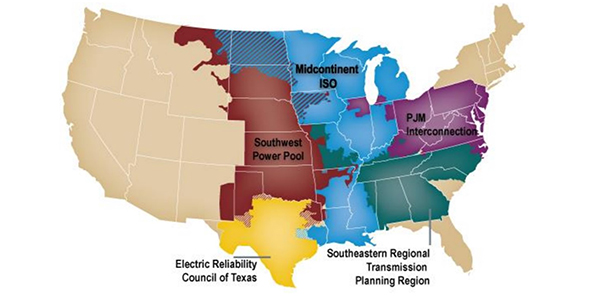By Amanda Durish Cook
CARMEL, Ind. — MISO is revising how it handles generator interconnections along its seams with neighboring balancing areas in a bid to satisfy several recent FERC mandates.
FERC issued the directives to MISO, PJM and SPP in September after finding that their joint operating agreements lack transparency around how they manage their affected-system impact studies. The commission ordered study procedures must contain:
- Easily referenced business practice manuals;
- Descriptions of modeling standards;
- Clearer modeling details for interconnection customers;
- A description of how MISO and SPP study the impacts on each other;
- Descriptions of how the three RTOs monitor each other’s systems during the course of each of their interconnection studies.
Compliance filings are due from the RTOs by Feb. 3.
FERC’s directives were the product of 18 months of examination after EDF Renewable Energy complained about the RTOs’ affected-system coordination. (See Affected-system Rules Unclear, FERC Says.)
At a Nov. 12 meeting of the Interconnection Process Working Group (IPWG), resource interconnection engineer Sumit Mundade said the RTO’s interconnection staff have worked up “preliminary language” in JOAs with both PJM and SPP to comply with all six directives. MISO has set aside time through January to continue revising its JOAs, he said.
Mundade said MISO and SPP won’t be able comply with FERC’s requirement that they set specific dates to exchange affected-system information and study results and instead proposed they use “formula dates” based on the start of the studies and include deadlines for data exchanges.
“With MISO and now SPP’s adoption of a three-phase group study process, fixed calendar dates are not optimal because kick-off dates are not fixed in advance,” Mundade explained.
MISO will also add JOA language to clarify MISO’s study criteria only apply to its facilities.
“FERC wanted to know whose criteria applies to which facilities,” Mundade said. “SPP study criteria apply to SPP facilities, and MISO criteria apply to MISO facilities.”
MISO is also proposing to apply its external resource interconnection service study criteria when it studies SPP and PJM interconnection projects, rather using its network resource interconnection service criteria.
“FERC only asked us to describe this, not change anything,” Mundade said.
MISO still faces the task of explaining how it monitors neighboring transmission systems for impacts during interconnection studies. Mundade said while monitoring will include “an identification of MISO projects with potential impacts to the SPP or PJM transmission system based on each RTO’s criteria,” those JOA revisions are still in the works.
MISO has also not yet decided how it will detail the process used to determine projects’ queue priority in an affected-system analysis and how it will allocate the costs of network upgrades required on an affected system.
“The proposed language is under development,” Mundade said, promising to return to the January IPWG with more specifics.
In addition to the two compliance filings, MISO plans to make two separate filings to change some aspects of the JOAs with SPP and PJM.
Pending approval from its neighbors, MISO will add separate JOA language requiring MISO and SPP to share cost estimates and construction schedules of network upgrades and to synchronize information-sharing with PJM so studies line up more closely with PJM’s interconnection timeline.
The additional filings will also make clearer that interconnection customers bear the costs of the affected-systems studies. Mundade said the separate JOA filings contain affected-system changes not required by FERC but represent improvements nonetheless.




